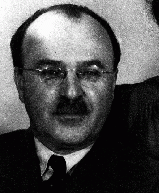
Franz Anton Ledermann
Born: October 16, 1889
Hirschberg, Germany
Franz was raised in a town in eastern Germany. The son of Jewish parents, he earned a law degree from Breslau University and a doctorate of jurisprudence from Geneva University in Switzerland. At the age of 35 he married Ilse Luise Citroen, a woman of Dutch-Jewish ancestry. The couple settled in Berlin where Franz had a successful law practice. The Ledermanns had two daughters.
1933-39: The Nazis came to power in January 1933. Ilse's Dutch relatives encouraged the Ledermanns to immigrate to the Netherlands, but Franz was reluctant to begin again in a new country. However, after the Nazis forbade Jewish lawyers to have non-Jewish clients, he decided to leave. The Ledermanns moved to Amsterdam, where they found an apartment on the city's south side. Franz got a Dutch law degree after three more years of schooling.
1940-44: Franz secured a job with a Dutch lawyer whose clientele was mainly Jewish refugees in the Netherlands. In May 1940 the Germans invaded and occupied the Netherlands. Beginning in 1941 Franz would, from time to time, do legal translations for Amsterdam's Jewish council. This work offered him some protection from deportation. Hoping that those who followed German instructions would not be harmed, he refused to believe the worst rumors about German "work camps," even after the Germans began deporting Jews in 1942.
On June 20, 1943, Franz and his family were deported to the Westerbork camp in the Netherlands. In 1944 they were sent to Auschwitz, where he perished. Franz was 54 years old.